This post may contain affiliate links. Please read our disclosure policy.
Red wine, oranges, lemons, peaches, apples, and more blend together to create the refreshing medley of juices that is Spanish Sangria. Treat yourself to this widely popular Spanish cocktail today!
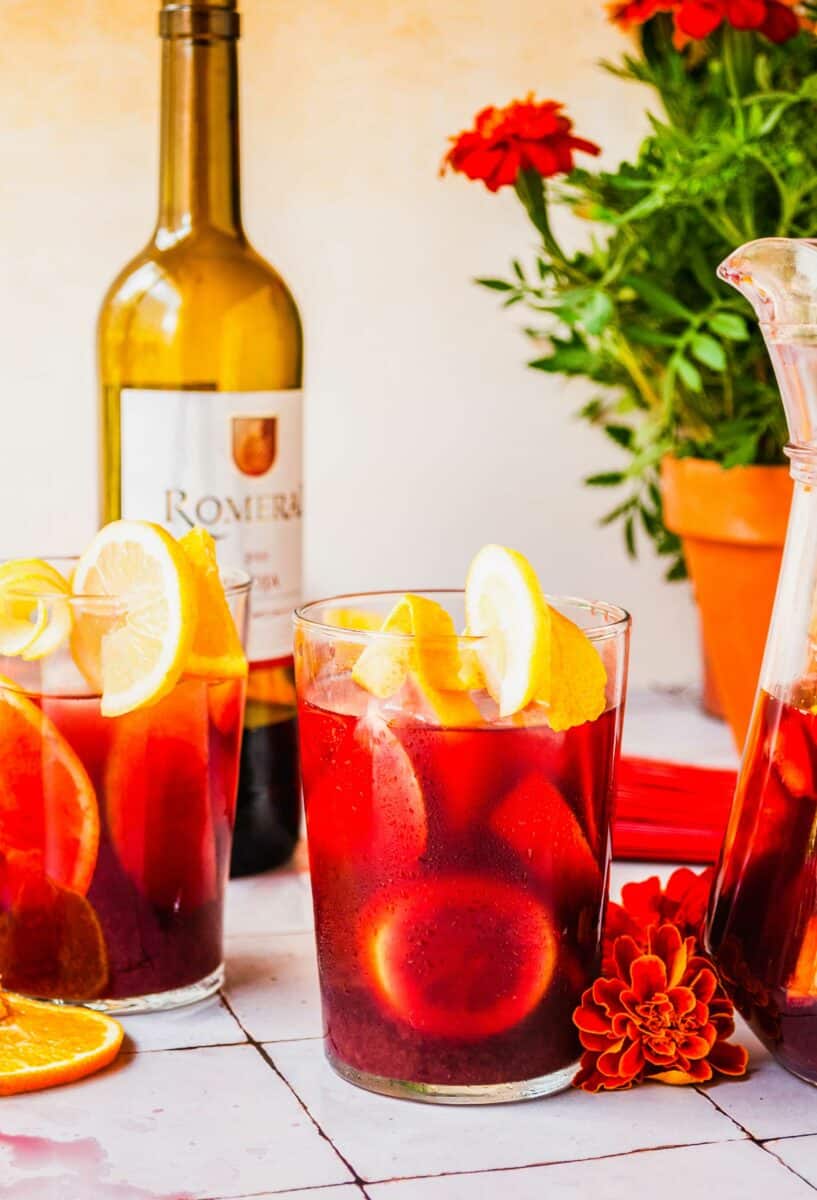
History of Spanish Sangria
There are a few drinks more refreshing and festive than traditional Spanish Sangria. It is consumed everywhere in Spain in large amounts during the hot Spanish summer months.
Every bar and restaurant has its own version, and so also almost every family. It is usually made in big batches to quench the thirst during summer family gatherings and barbecues with friends.
There are many versions of it, and many other countries have their own. Sangria can be made with other wines and different combinations of fruits and liquors however, only the red wine one is considered authentic Spanish Sangria, since it was the very origin of the other versions.
Did you know the name Sangria came from the Spanish word “sangre” (blood)?
Because of the red color of the wine of course! There are no weird ingredients in it! Haha
Sangria is a kind of fruit punch made with red wine, citrus fruits (whole and also in fresh juice form), and other fruits like peach, strawberry, apricot, combined sometimes with a dash of other liquors (citrus liquor, vermouth, brandy) and mixed with a sparkling soda like club soda at the very moment of serving. This final step is optional and it can be omitted.
It is very easy and quick to make and very make-ahead friendly, so it’s the perfect drink to prepare for potlucks, barbecues, and all kinds of summer gatherings.
There is no need to prepare individual cocktails for everybody, which is always a plus!
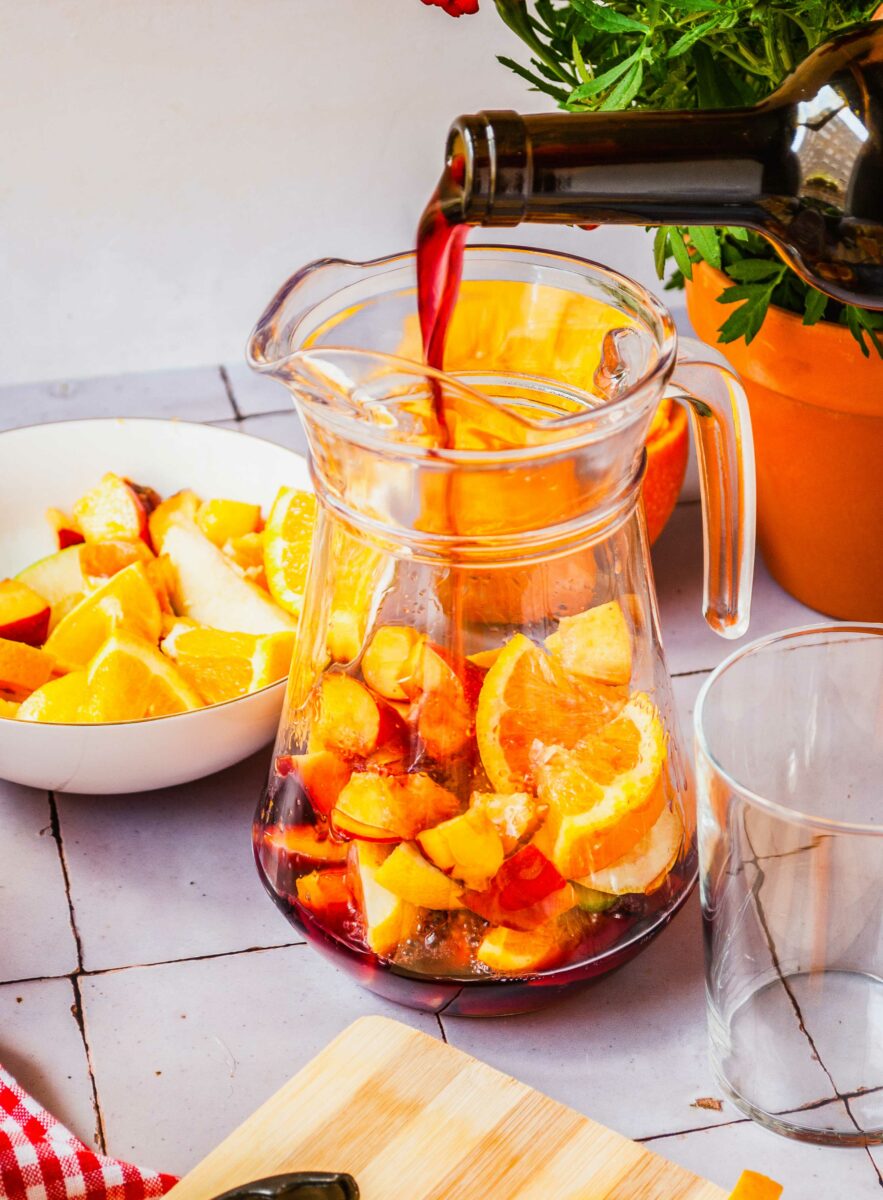
Notes on the ingredients
- Red wine: you can use almost any kind of red wine, but have in mind that the higher the quality of the wine, the better quality of the final result. Avoid any aged wines, and try to find a good medium-quality young wine. Spanish Rioja goes really well for Sangria, but Italian Chianti will be also a good option.
- Liquor: you can skip it, but I find that when used in small quantities it helps to develop the depth of flavor of the final Sangria. You can add vermouth liquor like the Italian Martini Rosso (which is essentially a spiced wine), any citrus liquor (Cointreau), or even brandy, but I much prefer the first two options.
- Fruits: essentially citrus fruits are a must, especially lemons and oranges. Other fruits that go well are: peaches, strawberries, plums, apples, and apricots.
Avoid using bananas or any mushy fruits or it will thicken the Sangria. Pineapple is another fruit to avoid since its flavor profile do not match with red wine.
- Fruit juice: Always made with fresh orange juice or lemon. Not any other fruits, and not bottled juices of any kind.
- Sparkling component (optional): Right before serving (usually poured in each glass) we top up the Sangria with a sparkly component, so leave some room for it at the top, for this you can use club soda (which is my recommendation, since it’s not sweet and it will not add any more sugar) or any orange or lemon soda of your choice.
- Sugar (optional): Depending on your liking and especially if the fruits are not very ripe (especially the orange juice) you can add a couple of tablespoons or more of regular white granulated sugar. If you use this make sure to dissolve it well into a bit of wine or juice, before pouring it into the Sangria mixture. Otherwise, it will sink to the bottom.
- Ice: Use regular-sized ice, and try to avoid small cubed ice (the one used for cocktails) since it will easily melt down, which results in watering down the Sangria, which is very sad.
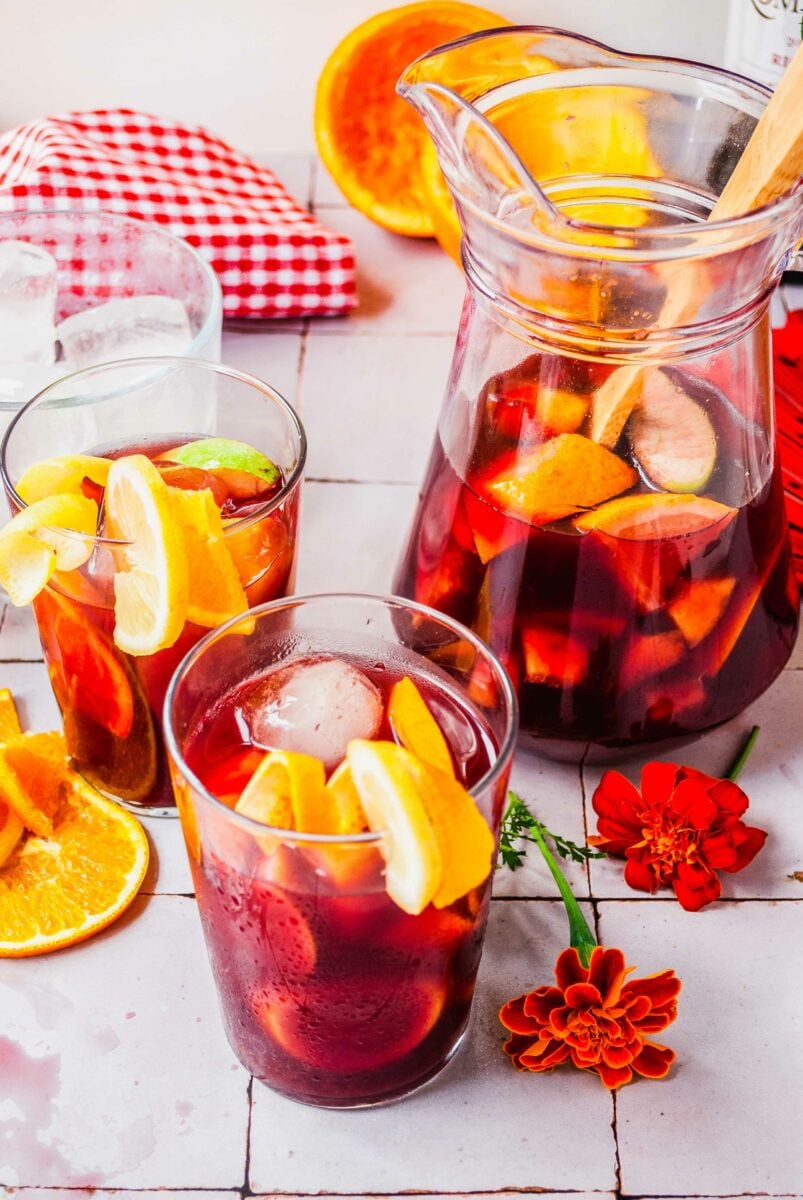
How early ahead can I make Spanish Sangria?
As previously mentioned, Spanish sangria is a wonderful make ahead cocktail! I love having a pitcher on hand before a party so I’m not running around whipping up cocktails. For best results, make a pitcher of sangria no sooner than 2 days before an event. While it can stay fresh for up to 4 days, the taste of alcohol becomes stronger the longer it sits, so it’s best when served within 48 hours unless the stronger taste is your preference.
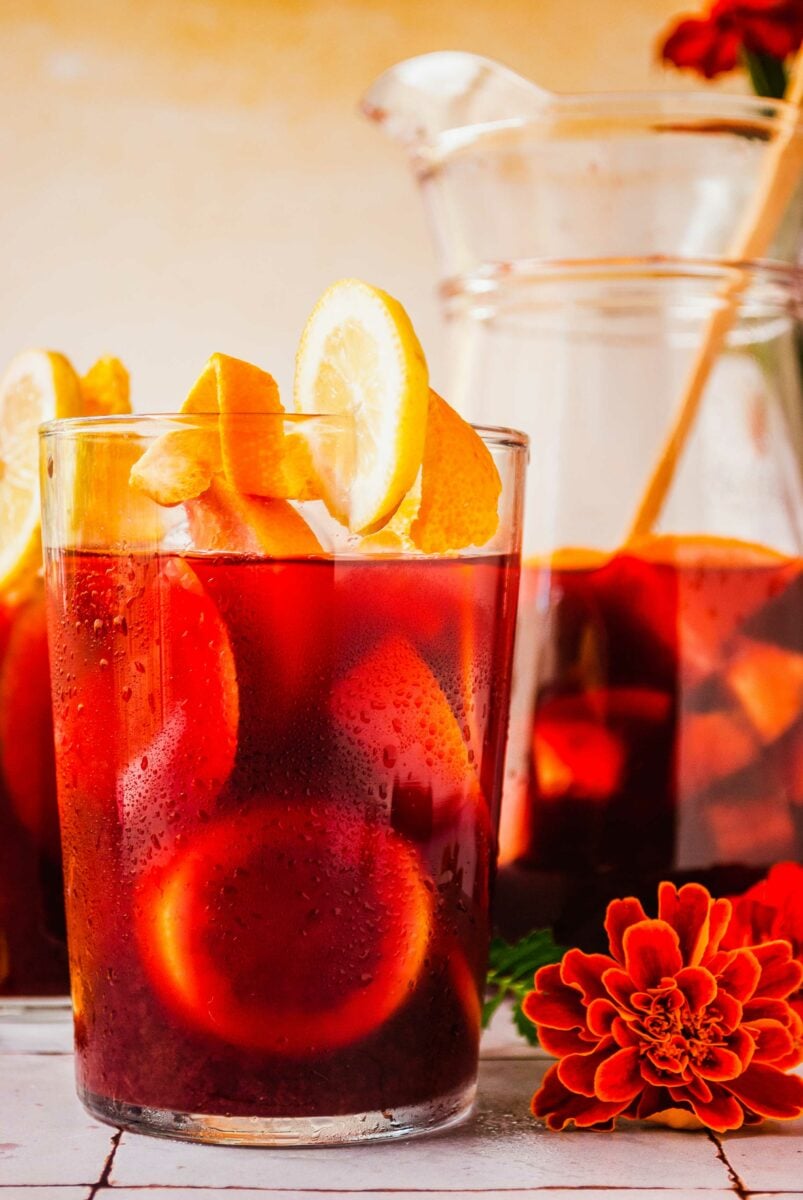
When is the best time to serve Spanish Sangria?
This is best known for being a sweet and refreshing summertime drink! Think about summery celebrations with friends – those are the best Spanish Sangria vibes. However, it’s also tasty the rest of the year too… It’ll be our little secret if you’re sipping on a glass of sangria this Christmas.
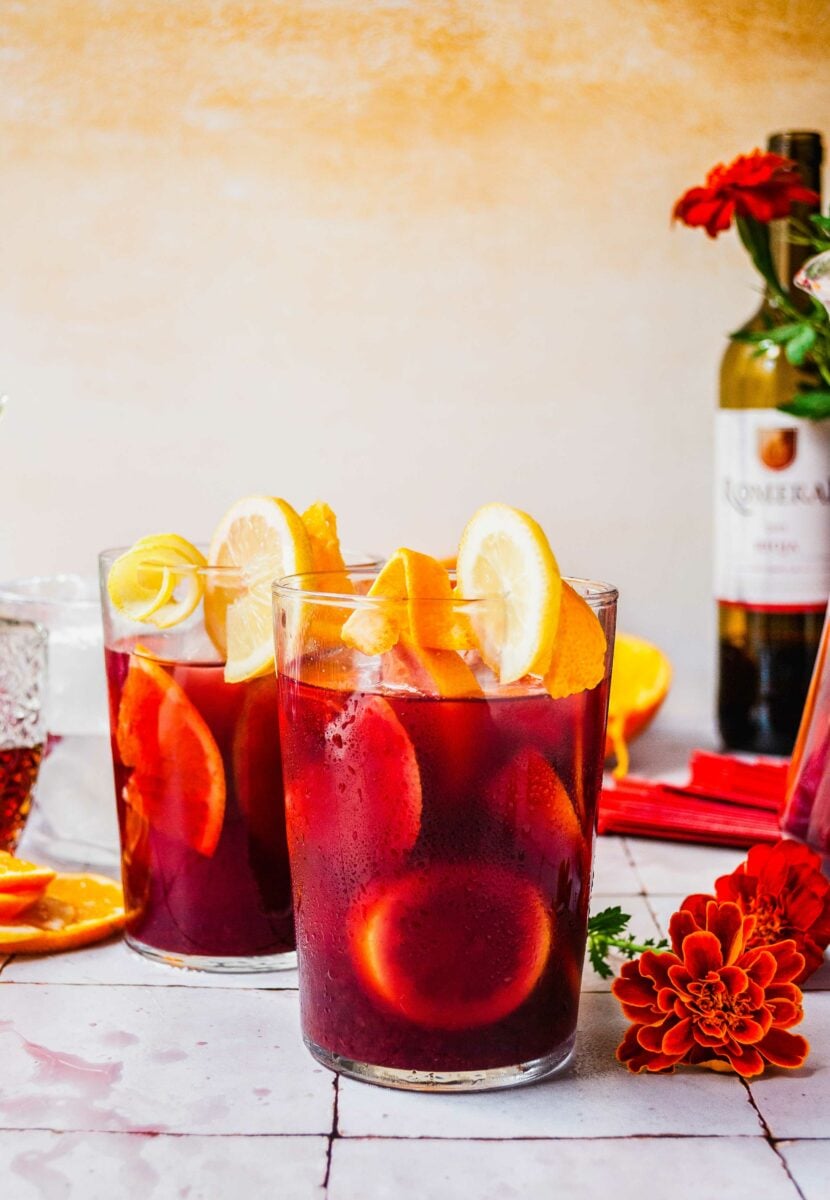
Beat that summer heat while it’s still here with more bright cocktails!
Strawberry Rickey
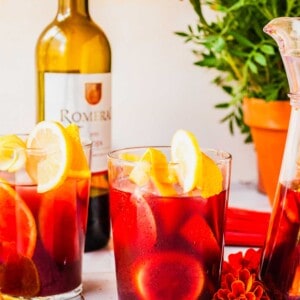
Spanish Sangria
Ingredients
- 1 bottle of red wine, I used Spanish Rioja
- 3 oranges
- 2 lemons
- 1 peach, pit removed
- 1 apple, core removed. I used a Granny Smith for the contrast in flavor and color.
- A generous dash of liquor, I used Italian Martini Rosso vermouth
- Club soda or citrus soda, optional
- 2 tablespoons granulated sugar or more to taste, optional
Instructions
- Start by washing your fruits well. Since we are going to use them with the skin on make sure you scrub them well.
Prepare the fruit as follows:
- Slice in wedges one of the oranges.
- Slice in wedges one of the lemons.
- Slice in wedges the peach.
- Slice the apple in thiner slices.
- Set aside.
- Juice another one of the oranges and set aside the juice.
- In a pitcher put the sliced fruits, add the orange juice, the bottle of red wine, and the splash of liquor. Mix well until combined. Do not add the ice at this moment. We are going to leave this Sangria mixture rest for a couple of hours.
- Taste and adjust to your liking. Add sugar if you find it necessary. Keep in mind that you might add a bit of sweet soda for some bubbly later.
- Let the mixture sit for at least a couple of hours in the fridge, so all the flavors in the fruits transfer into the wine and combine with the rest of the ingredients. You can also prepare it and let it sit overnight.
Prep the garnish fruit for the glasses:
- Peel half of the remaining orange and lemon in fine strips with a potato peeler and cut them in half if they are too wide.
- With a chopstick, roll one of the peels at a time around it and press gently for a few seconds, this will give you nice orange and lemon peel swirls. Cut them in shorter swirls and set them aside.
- Cut the other half orange and lemon in thick slices. Cut them in triangles leaving the skin to be the bottom part of each triangle. Make a tiny slit in the zest for the triangles to sit on the glass brim.
- Once the Sangria has been sitting for a couple of hours or overnight, transfer it into the serving pitcher. Leave some room for the sparkling drink in case you want to use it.
- Serve each glass with some ice, Sangria, some of the fruits, and a triangle of lemon and orange in the brim as well as one of the peel swirls. Top with additional soda, if desired.
- Enjoy! Remember you can eat the fruit after finishing your glass!

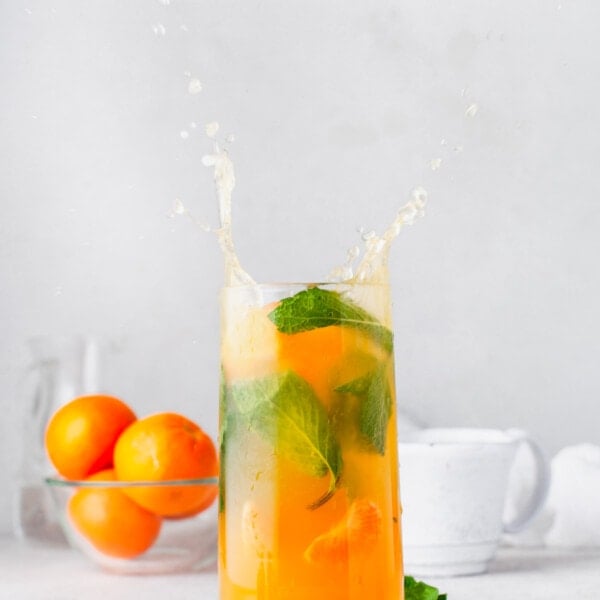
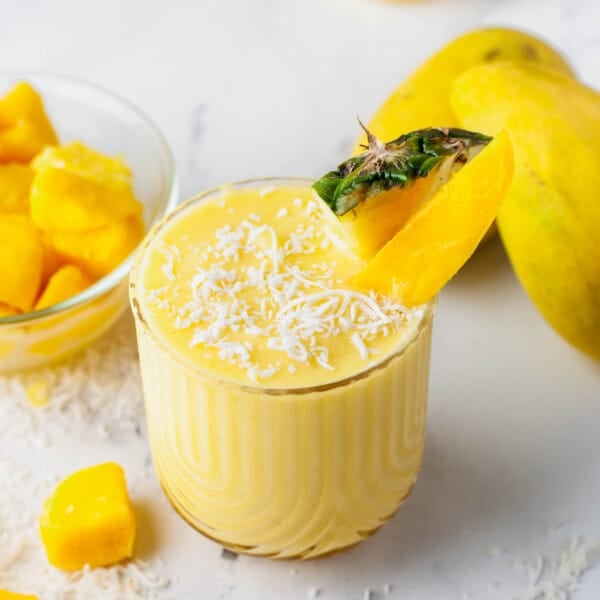
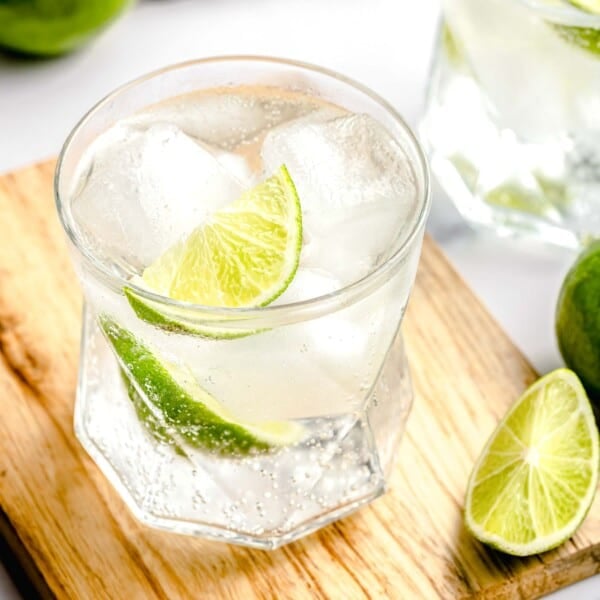
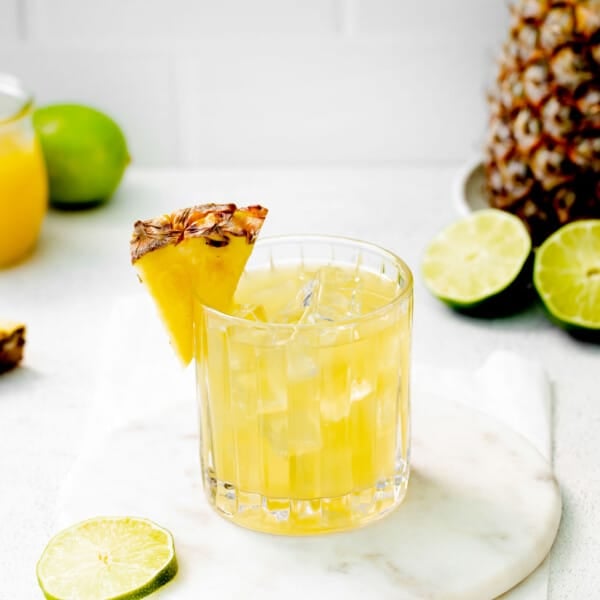







To be honest, I haven’t made this yet, but was searching for a truly authentic recipe that was made exactly like my family in Spain showed me how to make it when I was 15. It had no added liquor or liqueur, Not because I was underage, as you know Sangria is enjoyed by all ages there. My family in Cadiz made it without sugar either, just fruit and wine. But the type of fruit mattered, as did the type of wine. I’m so happy to have found your true Spanish version! Thank you!
i’m so glad you found this authentic spanish sangria recipe! the lady who developed this recipe for me is actually from spain and she said this was how her and her family made it growing up too!
Hello :) The recipe tasted grand…but…I found it hard to equate to the notion of “dicing” something into “wedges”? Dicing is a culinary knife cut in which the food item, let’s say a steak of sirloin, is cut into small blocks(like dice):) Wedges are cut from round vegetables(tomato, potato, lemon)into four or six pieces or more, equally, radially.
In a nutshell. Dicing something into a wedge, is impossible. Perhaps it’s worth amending the word dice for the word slice? Best wishes :)
Thanks for the feedback